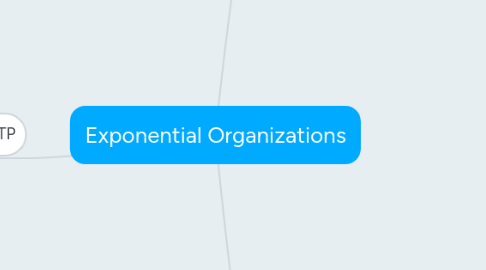
1. MTP
1.1. Definition
1.1.1. Massive
1.1.2. Transformative
1.1.3. Purpose
1.2. Examples
1.2.1. TED
1.2.1.1. Ideas worth spreading
1.2.2. Google
1.2.2.1. Organize the world's information
1.2.3. Singularity University
1.2.3.1. Positively impact one billion people
1.3. Why Important?
1.3.1. Enables coherent expontential growth
1.3.2. Binds collective aspirations
1.3.3. Attracts top talent across the ecosystem
1.3.4. Supports a cooperative and non-political culture
1.3.5. Enables agility and learning
1.4. Dependencies or Prerequisites
1.4.1. Must be unique
1.4.2. Leaders must walk the walk
1.4.3. Must support all three letters
2. Internal Characteristics (IDEAS)
2.1. Interfaces
2.1.1. Why Important?
2.1.1.1. Filter external abundance into internal value
2.1.1.2. Bridge between external growth drivers and internal stabilizing factors
2.1.1.3. Automation allows scalability
2.1.2. Dependencies or Prerequisites
2.1.2.1. Standardized processes to enable automation
2.1.2.2. scalable externalities
2.1.2.3. Algorithms
2.2. Dashboards
2.2.1. Why Important?
2.2.1.1. Track critical growth drivers in real time
2.2.1.2. OKRs create control framework to manage fast growth
2.2.1.3. Minimize exposure from errors because of short feedback loops
2.2.2. Dependencies or Prerequisites
2.2.2.1. Real-time metrics tracked, gathered and analyzed
2.2.2.2. OKRs implemented
2.2.2.3. Cultural acceptance by employees
2.3. Experimentation
2.3.1. Why Important?
2.3.1.1. Keeps processes aligned with rapidly changing externalities
2.3.1.2. Maximizes value capture
2.3.1.3. Faster to market (MVP)
2.3.1.4. Risk taking provides an edge and faster learning
2.3.2. Dependencies or Prerequisites
2.3.2.1. Measurement and tracking of expirments
2.3.2.2. Cultural acceptance (failure = experience)
2.4. Autonomy
2.4.1. Why Important?
2.4.1.1. Increased agility
2.4.1.2. More accountability at customer face
2.4.1.3. Faster reaction and learning times
2.4.1.4. Better morale
2.4.2. Dependencies or Prerequisites
2.4.2.1. MTP
2.4.2.2. Self-starting employees
2.4.2.3. Dashboards
2.5. Social Technologies
2.5.1. Why Important?
2.5.1.1. Faster conversations
2.5.1.2. Faster decision cycles
2.5.1.3. Faster learning
2.5.1.4. Stabilizes team during rapid growth
2.5.2. Dependencies or Prerequisites
2.5.2.1. MTP
2.5.2.2. Cloud social tools
2.5.2.3. Cooperative culture
3. External Characteristics (SCALE)
3.1. Staff On Demand
3.1.1. Why Important?
3.1.1.1. Enables learning (fresh perspectives)
3.1.1.2. Allows agility
3.1.1.3. Forms stronger bonds among core team
3.1.2. Dependencies or Prerequisites
3.1.2.1. Interfaces to manage
3.1.2.2. Clear task specifications
3.2. Community & Crowd
3.2.1. Why Important?
3.2.1.1. Increase loyalty to ExO
3.2.1.2. Drives expontential growth
3.2.1.3. Validates new ideas, and learning
3.2.1.4. Allows agility and rapid implementation
3.2.1.5. Amplifies ideation
3.2.2. Dependencies or Prerequisites
3.2.2.1. MTP
3.2.2.2. Engagement
3.2.2.3. Authentic and transparent leadersihp
3.2.2.4. Low threshold to participate
3.2.2.5. P2P value creation
3.3. Algorithms
3.3.1. Why Important?
3.3.1.1. Allows fully scalable products & services
3.3.1.2. Leverages connected devices and sensors
3.3.1.3. Lower error rate; stabilizes growth
3.3.1.4. Easily updated
3.3.2. Dependencies or Prerequisites
3.3.2.1. Machine or Deep Learning techniqques
3.3.2.2. Cultural acceptance
3.4. Leveraged Assets
3.4.1. Why Important?
3.4.1.1. Allows scalable products
3.4.1.2. Lowers marginal cost of supply
3.4.1.3. Removes having to manage assets
3.4.1.4. Increases agility
3.4.2. Dependencies or Prerequisites
3.4.2.1. Abundance or easily available assets
3.4.2.2. Interfaces
3.5. Engagement
3.5.1. Why important?
3.5.1.1. Increases loyalty
3.5.1.2. Amplifies ideation
3.5.1.3. Converts crowd to community
3.5.1.4. Leverages marketing
3.5.1.5. Enables play and learning
3.5.1.6. Provides digital feedback loop with users
3.5.2. Dependencies or Prerequisites
3.5.2.1. MTP
3.5.2.2. Clear, fair and consistent rules without conflicts of interest

